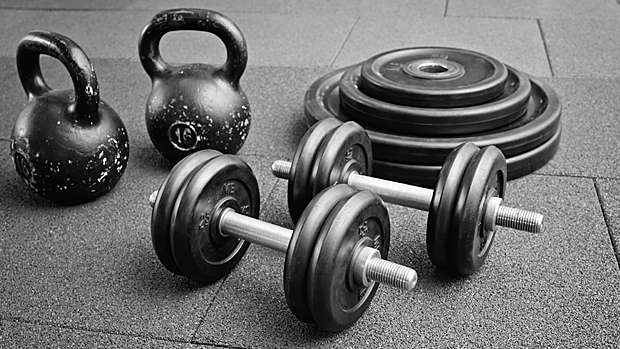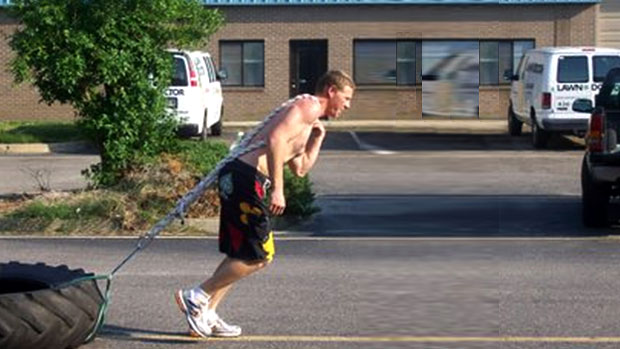Some lifters and coaches center their programs around certain pieces of equipment, like the barbell or kettlebell. Many of these people also like to demonize other types of equipment, like machines.
The reality is, no single piece of equipment is best for all jobs.
From barbells to machines, dumbbells to kettlebells, and from bands to medicine balls, each has a unique use that other implements can't match. Let's review.
Unique Use: Lifting heavy loads for max strength training – absolute loading.
The barbell allows you to work against the highest amount of overall load of any piece of common gym equipment in the free-weight category.
Even if you can easily do a 300-pound Romanian deadlift with a barbell, you'll have a hard time doing RDLs using two 150-pound dumbbells. And while you may be able to "move more weight" on a machine than you can with a bar, the actual load being applied to the body is greater with the barbell due to the lack of stability that's inherent with machines.
The barbell is the preferred tool when lifting the heaviest loads is the primary objective.

Unique Use: Lifting heavy while saving your lower back.
The trap bar is also best suited for lifting big loads. However, its unique benefit over the barbell is that it allows you to essentially get closer to the weight.
This is why many people find the trap-bar deadlift to be better on their lower back than the barbell deadlift. Beyond competitive powerlifting, there's no universal need to use a barbell for the deadlift, and the trap bar is a smarter option for most people.
Unique Use: Unilateral lifts for the upper body.
Bilateral lifts with emphasis on each side of the body working with a higher degree of independence. Allows for heavy lifting with less restriction relative to your grip and path of movement.
While you can't load to the same total capacity as with a bar, dumbbells are akin to the barbell due to their free-weight nature and loading capability. The dumbbell is more versatile than the barbell because it's more joint-friendly for most lifters. Your path of motion is more free, so you can better adjust an exercise to attend to any problem you may be dealing with.

Unique Use: Exercises that originate from traditional kettlebell lifting: swings, Turkish get-ups, snatches, windmills, goblet squats, bottoms-up variations.
A lot of dumbbell exercises can be performed with a kettlebell. Due to the kettlebell's unique structure (handle relative to center of mass), they're great for grip work and they can make certain shoulder training exercises feel better.
But the main advantage of kettlebells is when they're used for explosive lifts like swings, cleans, and snatches. You have to control the kettlebell to either catch it softly as it flips over, or decelerate it on the back-end of each rep.

Unique Use: Creating horizontal and diagonal lines of force. User-friendly angles. Various grip options (handle, bar, or rope).
All free weight and bodyweight exercises are loaded by gravity, which is a vertical line of force. But with cables, you're able to create a horizontal and diagonal line of force to work against, so workouts can be more comprehensive.
Cables help you create a more balanced workout by allowing you to load planes of motion that gravity doesn't load through free-weight exercises.
The dual adjustable cable column may be the most versatile tool in the gym. You can do most all basic exercises with it.
These multipurpose cable machines appear to just be scaled-down versions of the traditional cable crossover, but they have the advantage of having near unlimited adjustments of pulley heights and widths due to the adjustable cable arms.
You can design an entire training program with this machine with little compromise, unless absolute loading is your priority. By adding a bench, even more upper-body options become available.
There's also an innate core component to most every exercise performed in a standing position, especially with heavier loads. Some machines have heavier weight stacks allowing most anyone to train their entire body regardless of strength level.

Unique Use: Throwing to build explosive power in multiple directions.
Being able to throw a medicine ball makes it unique. It's also what makes it the best overall tool for developing total-body explosive power.
Total-body power exercises use as many muscles as possible in a sequential and explosive (fast) manner to obtain maximal force in what we refer to as the three pillars of power:
- Vertical or diagonal power
- Horizontal power
- Rotational power
Though each sport has its own unique set of skills, these three pillars of power provide the source for all explosive actions in sports.
Medball throwing exercises are ballistic in nature, which involves a coordinated effort by the entire body to summate force in an explosive manner. Athletic movements – punching and kicking, swinging a bat, sprinting, jumping etc. – are driven not by power generated in just one specific area of the body, but as an integrated expression of individual muscles producing power in a smooth, coordinated sequence.
When throwing the ball, unlike when lifting weights, you don't have to slow down at the end of the range of motion – you can just let the ball fly. So simply throwing the ball in different directions (power is direction specific) trains your body to generate explosive power without putting on any brakes.
Also, whereas Olympic weightlifting can be difficult to learn and trains only in the vertical or diagonal power pillar, explosive medball exercises are easy to learn and require you to move fast and explosively in all three power pillars.
Use a variety of throwing exercises – throwing either against a wall or into open space – to help you become more explosive and therefore more powerful and athletic.

Unique Use: More tension on specific muscles. Heavy, stable loading.
Free weights excel by forcing you to use your stabilizer muscles. Plate-loaded machines excel by providing you more stability, which allows you to work certain areas of your body harder.
Try this experiment on a chest-supported row machine – plate-loaded or selectorized:
Find a weight where you can do a set of 8-12 reps while seated on the machine but without your chest being supported by the pad. When you can't do any more reps, don't stop the set. Simply move slightly forward so your chest is now supported by the pad. You'll be able to continue to do more reps with your chest supported.
Even though the same pulling muscles are involved in the row whether or not your chest is supported, the chest unsupported row also involves your lower-back musculature to keep your torso stable.
This additional demand limits what you can do with the muscles you're using to perform the rows. On the other hand, with your chest supported, your body is able to utilize the muscles involved in the rowing action to a higher degree because the lower-back involvement is no longer a limiting factor.
This demonstrates the benefit of the added stability that machines offer when it comes to maximizing muscle recruitment.
Unique Use: Tension through more of the range of motion, especially with movement patterns that have a curve to them – leg extension, leg curl, pullover, etc.
Free weights fall short when it comes to keeping consistent tension on the muscles throughout the range of motion. That's the area where selectorized machines excel.
Selectorized machines are designed with a CAM system, which is the bean-shaped thing on the machine that rotates as you do each rep. The CAM is set up to offer you a much more consistent resistance throughout the entire range of motion.
This also gives you much more time under tension because your muscles don't get the same chance to rest at the bottom or top position of the range like they do when using free weights. Selectorized machines also offer the same stability benefits as plate-loaded machines.
This is why there's no reason to avoid machines. In fact, for strength and muscle, machines should be used in conjunction with free weights.
Unique Use: Fast reps for improving speed strength.
Can also be used as a primary source of resistance for strength, power, and hypertrophy in multiple planes of motion.
One obvious benefit to bands is their portability. They can be a valid standalone tool for times when you can't make it to the gym. Yes, you CAN build muscle with bands when you know how to use them in a way that maximizes their benefits.
When you're in the gym, bands can be used in addition to free weights and machines to create accommodating resistance to create more tension as you extend on upper-body pressing exercises, squats, deadlifts, etc. to help optimize the strength curve.
The unique benefit bands offer is the ability to perform very fast reps under control because the weight doesn't gain its own momentum, which would then be decelerated, subsequently risking joint and connective tissue injury.
When it comes to speed training with bands (dynamic effort), a lot of non-powerlifters copy what they see powerlifters doing – attaching bands to each side of a bar and doing fast bench presses. That's fine. But you don't need to just use a barbell to do speed training with bands. In fact, it makes more sense to do strength-speed work for all of the main movement patterns.
Movement-speed training exercises like the band exercises highlighted in 15 Exercises for a Powerful Upper Body focus on improving your rate of force development – how quickly you can use your strength.
Remember: power = strength × speed. The heavier the load you're working against, the slower your movement becomes. For this reason, the principle of specificity dictates that to do all you can to improve your power, don't just do exercises that involve moving against high loads (strength exercises). Also do exercises that require you to move at high speeds.




